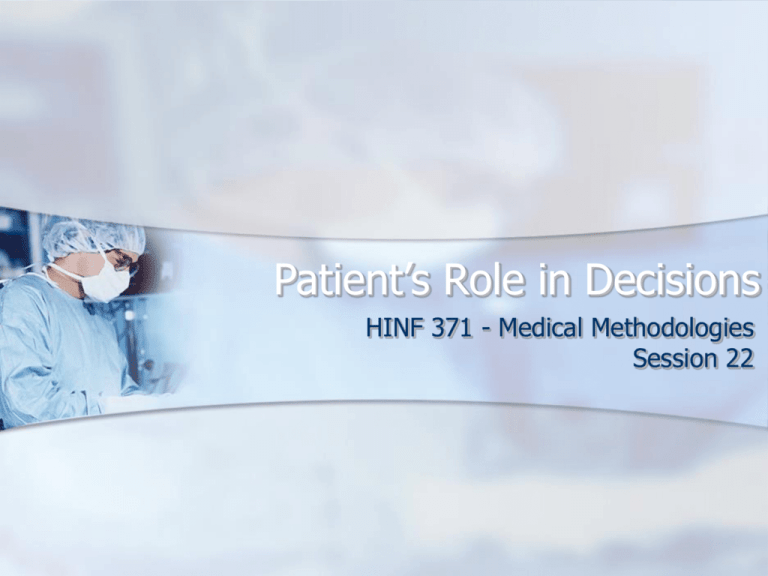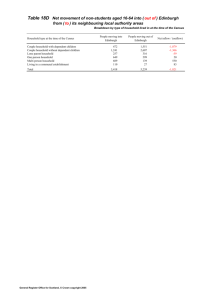
Patient’s Role in Decisions
HINF 371 - Medical Methodologies
Session 22
Objective
To understand the role of patients in
medical decision making
To discuss/explore technology that
would enable more active
participation
Reference
Jimison HB and Sher P p (2000) Chapter 13: Advances in
Presenting Health Information to Patinets, in Decision
Making In Health Care: Theory, Psychology and Applications,
Cambridge University Press, USA
McKinstry, B (2000) Do patients wish to be involved in
decision making in the consultation? A cross sectional survey
with video vignettes, BMJ, Vol:321; pp:867-871
Kravits RL and Melnikow J (2001) Engaging patients in
medical decision making, BMJ, Vol:323, pp:584-585
Holbrooks A, Labiris R, Goldsmith CH, Ota K, Harb S, Sebaldt
RJ (2007) Influence of decision aids on patient preferences
for anticoagulant therapy: a randomized trial, CMAJ,
176(11), pp 1583-7
Control: Who really makes the decisions
100
Patient/Family
“Control”
0
The “System”
Low
Acuity
High
1. Control – who makes the final decision influencing outcome?
2. Influences – family, friends, co-workers, religion, values, money
3. Real opportunity to influence health costs/outcomes – influence on the
choices made – behavioral change
4. Current model – tests, diagnosis, treatment (meds or procedures)
Drs. Eby and Kilo (2006) Presentation “Inconvenient Truths” in 2006 IHI National Forum
Driver of patient participation
Political trends – experienced
consumers – patients’ have rights
Ethics – autonomy versus beneficence
Research on health services –
involvement in decision making
results in better health outcomes
Can patients decide?
Can patients take a leading role in making
treatment decisions
Uncertain scientific evidence
Value of health status in patients’ eyes
Patients’ attitude of risk (probability, severity,
timing of an adverse outcome)
Do they want to?
What if doctors and public health
professionals don’t like their choices
Less effective treatment options
Less cost-effective treatment options
Already deciding - Passively
Mild and Moderate Hypertension
Value medical treatment less than
doctors
More distressed with side effects
May result in strokes and heart attacks
50-65 percent of chronic disease
patients adhere treatment
Do they want to?
Breast cancer study of 1012 women
400 patients watched videos of shared and direct
approach in treatment decisions
22% want to select treatment
44% want to collaborate
34% delegated
Physical problems – delegation
61 years older – delegation
Higher social class – shared
Smoking – shared
Not generalizable so doctors need to assess.
But everybody wants information.
Provision of Health Information
Higher ratings of patient satisfaction linked
to greater information exchange
Access to information enables patients to
be more active participants in the
treatment process and better outcomes
Health education is part of all health
professional – patient/client communication
Self-efficacy and power
Powerlessness a broad risk factor for
disease
Objectives
Empowerment
Self-efficacy
Goal setting
Problem solving
Connections
Adherence – compliance
Failure
Failure
Failure
Failure
to
to
to
to
take medications
keep appointments
follow recommended diet
follow preventive health practices
Types of information
Wellness and Prevention (nutrition,
exercise, first aid)
Diseases, screening, triage, tests and
treatments
Informed consent and advance directives
Medical Histories, home medical records,
and preparation of office visits
Shared decision making
Social support and communication with
others
Choosing a doctor, hospital, health
insurance
Models of information transfer
Brochures and pamphlets
Advantages
Point
of Care information
Refer when needed
Good for contact information
Disadvantages
Stand-alone
Needs
to be concerned with cultural
sensitivity, language, readibility, literacy
levels
Models of Information Transfer
Media
Advantages
Widely available
Lower cost
Telephone
(prerecorded information,
advice lines, reminders and
surveys)
Disadvantages
Might be biased
Flavour of the
month
Alarmist
Advantages
Less costly
Ability to triage
Disadvantages
Might be frustrating
Invasion of privacy
Models of Information Transfer
Video tapes
Advantages
Good
medium for education and training
Serves to more senses
Disadvantages
Harder
and probably more expensive to
produce
Might be biased
Models of Information Transfer
Computers and Telecommunications
(commercial software)
Advantages
Medium
that can integrate all of the above
Interactive
Supports individualization
Support groups
Internet – viewer beware – (e-mailing,
mailing lists, FTPs, listservers, Chat, etc.)
Disadvantages
Literacy
and access
Rank
Country or Region
1
2
3
4
5
6
United States
China
Japan
Germany
India
Brazil
7 United Kingdom
8
9
10
11
12
13
14
15
16
17
18
19
20
Korea (South)
France
Italy
Russia
Mexico
Canada
Indonesia
Spain
Vietnam
Turkey
Australia
Taiwan
Philippines
TOP 20 Countries
Rest of the World
Total World - Users
Internet Users,
Penetration (%
of Population)
% of World Broadband
Broadband
Users
Subscribers Penetration
210,575,287
162,000,000
86,300,000
50,426,117
42,000,000
39,140,000
69.70%
12.30%
67.10%
61.10%
3.70%
21.00%
18.00%
13.80%
7.40%
4.30%
3.60%
3.30%
58,136,577
35,300,000
25,755,080
14,085,232
2,100,000
5,846,000
19.30%
2.70%
20.00%
17.10%
0.20%
3.10%
37,600,000
62.30%
3.20%
12,993,354
21.50%
34,120,000
32,925,953
31,481,928
28,000,000
22,700,000
22,000,000
20,000,000
19,765,033
16,511,849
16,000,000
15,085,600
14,500,000
14,000,000
915,131,767
257,978,158
1,173,109,925
66.50%
53.70%
52.90%
19.50%
21.30%
67.80%
8.90%
43.90%
19.40%
21.10%
71.90%
63.00%
16.00%
21.70%
11.00%
17.80%
2.90%
2.80%
2.70%
2.40%
1.90%
1.90%
1.70%
1.70%
1.40%
1.40%
1.30%
1.20%
1.20%
78.00%
22.00%
100.00%
14,042,728
12,699,000
8,638,873
1,200,000
3,728,150
7,675,533
n/a
6,654,881
n/a
n/a %
2,773,685
3,939,288
n/a
n/a %
n/a
n/a %
27.40%
20.70%
14.50%
0.80%
3.50%
23.70%
0.30%
14.80%
3.70%
18.80%
NOTES: (1) World Internet User Statistics were updated on June 30, 2007. (2) Additional data for individual countries
and regions may be found by clicking each country name. (3) The most recent user information comes from data
published by Nielsen//NetRatings, International Telecommunications Union, Official country reports, and other
trustworthy research sources. (6) Data from this site may be cited, giving due credit and establishing an active link
back to InternetWorldStats.com. Copyright © 2000 - 2007, Miniwatts Marketing Group. All rights reserved.
Characteristics of household Internet users, by location of access
(Any location)
1999
2000
2001
Any location
% of all households
51.3
60.2
2002
2003
All households
41.8
61.6
64.2
Household type
Single family with unmarried children under
age 18
59
71.2
80.5
81.2
83.7
Single family without unmarried children
under age 18
38.7
46.7
55.6
58.9
63
One-person household
22.1
27.9
36.2
37.5
39.8
Multi-family household
55.1
64.3
73.9
75.3
73.2
Age of head of household
Under age 35
53
66.3
76.2
75.4
79.5
Age 35 to 54
54.9
65.7
74.1
75.5
78.8
Age 55 to 64
32.7
42.4
52.5
56.3
59.2
Age 65 and over
10.1
13.9
19.3
21.6
24.9
Education of head of household
Less than high school
16.1
22.4
29.9
30.2
31.6
High school or college
44.4
55.2
64.6
65.7
69
University degree
70.1
79.1
85.8
86.8
87.8
Household income
Lowest quartile
18.8
23.9
31.6
33
35
Second quartile
29.2
42.8
51.8
50.9
56.3
Third quartile
48.1
60.6
70.1
74.7
75.3
Highest quartile
71.2
77.9
87.3
87.9
90.3
Note: The tables of the Household Internet survey (HIUS) available from 1997 to 2003 are replaced by the tables of the
Canadian Internet use survey (CIUS) beginning with 2005. The unit surveyed is now the individual rather than the household.
Only adults aged 18 years and over were surveyed.
Source: Statistics Canada, CANSIM, tables (for fee) 358-0003, 358-0004, 358-0005 and 358-0017.
Last modified: 2005-02-18.
Principles of Presentation and
Interactivity
Interface design
Tailoring health information
Incorporating preferences
Barriers of Access
Cultural
Language
Reading level
Level of education and medical
expertise
Interface design
Give the user control
Reduce the user’s memory load
Provide immediate feedback and the option of
help any point
Use familiar metaphors – windows file folders
Keep the interface consistent
Adapt to user
Self-paced instruction
Ability to repeat, review and receive coaching
Tailor language, reading level, and medical experience
Tailor based on health risk assessment
Provide automated, tailored record of patient
understanding and education









